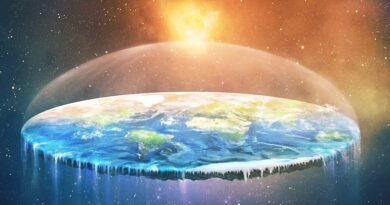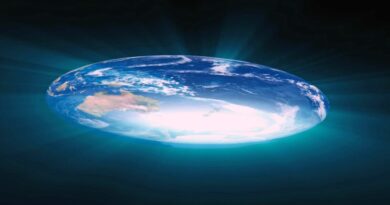Using weather to disprove the flat Earth hypothesis

That cause turned deadly over the weekend when “Mad” Mike Hughes, “self-styled daredevil, flat-Earth theorist and limousine-jumping stuntman” died in a rocket accident while trying to prove the flat-Earth hypothesis correct.
But even the weather shows the Earth isn’t flat. Here’s how.
If the flat-Earth hypothesis were true …
You would be crushed to death
Because of the way gravity works, which we all encounter in our daily lives, every molecule of air would be drawn to the Earth’s center of mass. Because the Earth is a globe, this means the atmosphere settles around the Earth, pulled toward Earth’s center, but is stopped by the Earth’s surface. The air pressure depends on height through a relationship known as hydrostatic balance. But in most places where we live, the air pressure is within tolerable limits.
But if the Earth were flat, a disproportionately large chunk of the air would be drawn toward the center of the “disk” that Flat Earthers believe in. Air pressure would range from near zero — or no atmosphere — at the edge of the disk to massive values toward the middle. So if you lived in, say, Australia or southern South America, you’d probably suffocate from a deficit of oxygen. And if you lived too close to the North Pole, you’d end up getting crushed by the weight of the atmosphere.
Rain and hail would fall sideways, and you might drown
On a flat Earth, the pull of gravity would be directed toward the planet’s middle. Flat Earthers contend that’s the North Pole. So rain, hail and every other form of precipitation would fall toward the North Pole.
At the pole, and close to it, all that precipitation in the air would converge and eventually pile up. Above and near the pole, the moisture would pile up high into the sky. The oceans would bulge up too. With the temperatures that exist at the North Pole, it might freeze — leaving giant ice pylons towering high into the sky. Some of it could be liquid, so there would be a column of water suspended in midair.
Through that same process, a rocket launched into the air would eventually find itself returning toward the North Pole, rather than the Earth’s surface.
The sun would never set
Have you ever experienced nighttime? Then you’ve witnessed proof that the Earth isn’t flat.
Flat Earthers say the sun is 32 miles wide — or about the diameter of the city of Houston. And they argue that the sun rides around in circles about 3,000 miles above the Earth.
If this were the case, the sun would never set. Because the Earth is supposedly flat, there would be nothing for the sun to set below if it were to travel along such an arc.
I crunched the numbers based on what the flat-Earth proponents say. Even in the dead of winter, the sun would never drop below 14.7 degrees altitude in Washington, D.C. That’s about the same height the sun appears around 7 p.m. on July evenings.
We would all freeze … or burn
Flat Earthers say the sun is 32 miles wide. (Side note: I checked their math twice and found an error. If the sun were really only 3,000 miles above us, as they claim, it would have to be about 27.9 miles wide, not 32. But even that is ignoring other problematic issues.)
For the sake of argument, let’s say the sun is 32 miles wide. And it’s parked 3,000 miles above flat Earth’s surface. If we keep their tiny sun at the same temperature as the actual sun (which is really roughly 865,000 miles in diameter), we can do the math to figure out how much solar radiation we would get.
It may surprise you to learn that the flat-Earth disk has nearly two and a half times the surface area as the actual curved version of Earth. If we assume the Flat Earthers’ tiny sun is heating it all, we’d freeze — missing out on more than a third of the solar radiation we actually get from the sun.
In other words, human life wouldn’t exist.
But let’s say we keep the surface area of the flat Earth the same as our actual planet. If we distributed the same intercepted solar energy over that Earth, we would be way, way too hot. Most, if not all, locations on Earth would be uninhabitable.
Lunar eclipses? Well … no.
You may have seen the moon plunged into a blood-red hue during a total lunar eclipse, with dim sunlight passing through the atmosphere bathing the moon in its eerie glow. Lunar eclipses are much more readily visible than solar eclipses. But Flat Earthers have an alternate explanation for what makes a lunar eclipse.
In reality, it’s an alignment in which the Earth intercedes between the sun and moon, eclipsing moon-bound sunlight. But such a lineup wouldn’t be possible, according to Flat Earthers, who say the sun and moon are constantly drifting in circles above a flat Earth’s surface.
Instead, their hypothesis is that a “shadow object” orbiting the sun enters a lineup between the sun and the moon. This shadow object, also dubbed the “antimoon,” apparently is translucent. That, they say, filters out some — but not all — of the light.
But wait a second … ignoring for the moment the fact that the sun would never set on a flat Earth, this is still impossible.
When we see the partial phases of a lunar eclipse, we witness the moon disappearing behind the round edge of Earth’s shadow — not a flat shadow.
However, if the flat-Earth theory were true, millions of people perpendicular to the sun-moon lineup would see a fully eclipsed first- or last-quarter moon. That doesn’t happen.
Flat Earthers also struggle to explain moon phases. If their theory were correct, everyone on Earth would see a different moon phase at the same time depending on which “side” of the supposedly 32-mile-wide moon they were on. That simply doesn’t happen.
The jet stream? Forget about it.
The jet stream forms over steep temperature gradients at the mid-latitudes; it’s driven by the thermal wind, which helps distribute heat energy through the atmosphere. The swiftly moving river of air screams eastward, its poleward tendency balanced by the Coriolis force. The Coriolis force stems from the Earth’s rotation.
In the Northern Hemisphere, the Coriolis force deflects air parcels to the right; south of the equator, it’s to the left.
But without a rotating system, we’d have no jet stream snaking its way about the poles. We’d have no big sprawling storm systems like nor’easters. We’d have no spinning areas of high or low pressure. Those air masses might still exist, but there would be no “rule” to their orientation or spin. Any weak spin would be random.
Despite this, tornadoes and waterspouts could still exist on a flat Earth. Those depend on smaller-scale wind dynamics and can’t “feel” the Earth’s rotation. However, at present, nearly all tornadoes in the hemisphere spin counterclockwise because the larger-scale storm systems that give rise to them do “feel” the Coriolis force. Those larger-scale mid-latitude systems encourage supercell thunderstorms and tornadoes to spin in one particular way.
There would be no hurricanes
Hurricanes couldn’t form either. It’s the same reason there are no hurricanes on (or near) the equator — the strength of the Coriolis force is zero there.
The aurora australis would have some issues
The flat-Earth “model” has a clear-cut North Pole, but what about a South Pole? The flat-Earth movement says the southern edge of the world is bordered by ice — Antarctica. It appears there is no definitive South Pole in the model, however.
For starters, the southern lights, or aurora australis, are routinely visible in Antarctica and occasionally in southern Tasmania and New Zealand. That’s because of their proximity to the magnetic South Pole. No South Pole, no southern lights. One point for a round Earth.
But moreover, the Earth’s magnetic field results from its spinning, superheated core largely composed of iron. It’s so hot, but under so much pressure, that some hypothesize it may be in plasma form despite behaving like a solid. That spinning mass is what generates Earth’s protective magnetic field.
Magnets have a north and south pole. If the North Pole exists, as it does in the flat-Earth theory, then typically the South Pole would be beneath it, on the “underside” of Earth, rather than near Antarctica. It’s another gap that Flat Earthers can’t explain.
If they do discount the idea of Earth’s core or magnetism, then where do the lights come from? If they buy the idea of a spinning magnetic core, where would you put the 750-mile-wide mass? Flat Earthers have yet to explain any of this.
Ocean currents would be screwy
Ocean currents on a flat Earth would be downright weird. The lack of the Coriolis force, coupled with virtually sideways gravity, along with the method and distribution of heating, would lead to truly bizarre current behavior.
All the existing ocean currents in the world can be explained in tandem with the proven fact of a round Earth. Yet again, Flat Earthers can’t round out their arguments.
This article has been archived for your research. The original version from The Washington Post can be found here.


